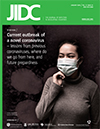Outbreak investigation of septicemic salmonellosis in calves
DOI:
https://doi.org/10.3855/jidc.12087Keywords:
Salmonella Dublin, Bos taurus, Carrier, Blood, Culture, PCRAbstract
Introduction: An early and accurate diagnosis of septicemic salmonellosis is critical for implementing timely and proper treatment, prevention, and control measures.
Methodology: Here, we report a study on three outbreaks of septicemic salmonellosis in calves from Midwestern Brazil.
Results: the morbidity, mortality and lethality rates were of 10.55%, 2.79%, and 26.4%, respectively. Higher susceptibility was detected in Bos taurus than in Bos indicus cattle. Clinical manifestations consisted of apathy, hyperthermia, difficulty breathing and panting, and pallor of the mucous membranes. Chronic cases had necrosis of the tail tip and ears. Gross findings included enlarged liver, non-collapsed edematous lungs and diphtheritic enteritis. Significant histopathological changes included paratyphoid nodules in the liver and acute interstitial pneumonia. Salmonella enterica subsp. enterica serotype Dublin was detected by culture and by PCR from the blood of live calves, and from the spleen, liver, bile, mesenteric lymph node and lung samples of necropsied calves.
Conclusions: We suggest that in clinical cases of septicemic salmonellosis, blood samples are better than fecal samples for detection of the agent, being a sound test to identify animal carriers in the herd.
Downloads
Published
How to Cite
Issue
Section
License
Authors who publish with this journal agree to the following terms:
- Authors retain copyright and grant the journal right of first publication with the work simultaneously licensed under a Creative Commons Attribution License that allows others to share the work with an acknowledgement of the work's authorship and initial publication in this journal.
- Authors are able to enter into separate, additional contractual arrangements for the non-exclusive distribution of the journal's published version of the work (e.g., post it to an institutional repository or publish it in a book), with an acknowledgement of its initial publication in this journal.
- Authors are permitted and encouraged to post their work online (e.g., in institutional repositories or on their website) prior to and during the submission process, as it can lead to productive exchanges, as well as earlier and greater citation of published work (See The Effect of Open Access).








